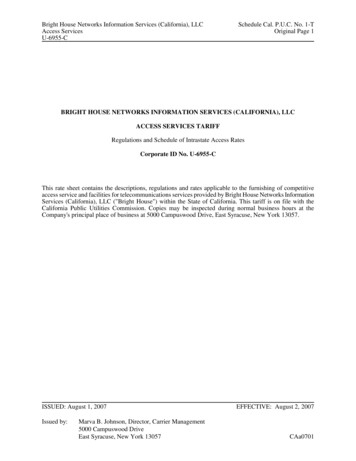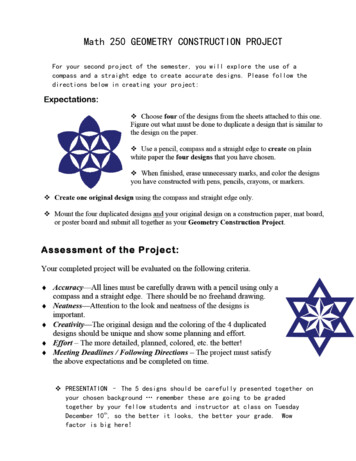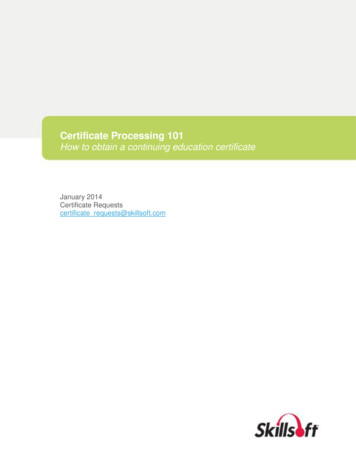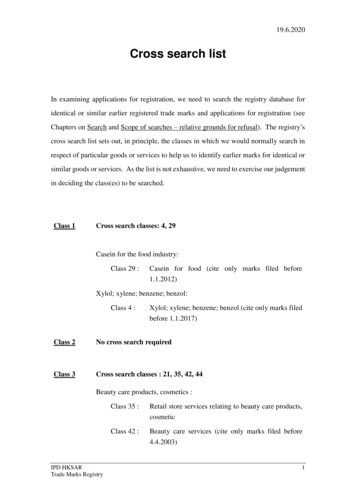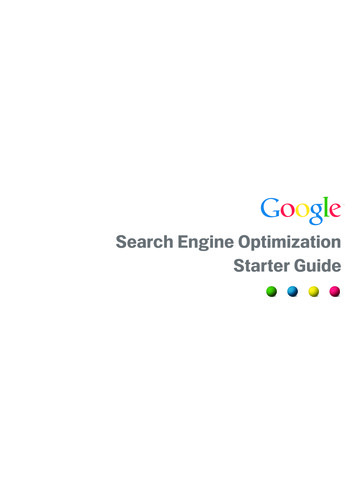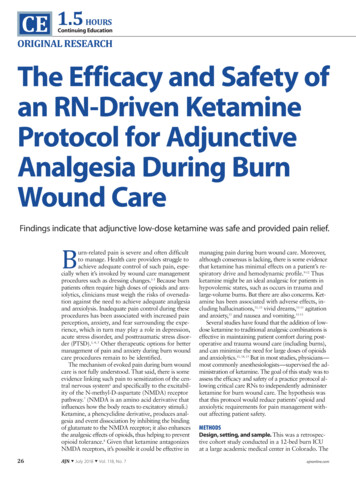
Transcription
CE 1.5HOURSContinuing EducationORIGINAL RESEARCHThe Efficacy and Safety ofan RN-Driven KetamineProtocol for AdjunctiveAnalgesia During BurnWound CareFindings indicate that adjunctive low-dose ketamine was safe and provided pain relief.Burn-related pain is severe and often difficultto manage. Health care providers struggle toachieve adequate control of such pain, especially when it’s invoked by wound care managementprocedures such as dressing changes.1-3 Because burnpatients often require high doses of opioids and anxiolytics, clinicians must weigh the risks of oversedation against the need to achieve adequate analgesiaand anxiolysis. Inadequate pain control during theseprocedures has been associated with increased painperception, anxiety, and fear surrounding the experience, which in turn may play a role in depression,acute stress disorder, and posttraumatic stress disorder (PTSD).1, 4, 5 Other therapeutic options for bettermanagement of pain and anxiety during burn woundcare procedures remain to be identified.The mechanism of evoked pain during burn woundcare is not fully understood. That said, there is someevidence linking such pain to sensitization of the central nervous system6 and specifically to the excitability of the N-methyl-D-aspartate (NMDA) receptorpathway.7 (NMDA is an amino acid derivative thatinfluences how the body reacts to excitatory stimuli.)Ketamine, a phencyclidine derivative, produces analgesia and event dissociation by inhibiting the bindingof glutamate to the NMDA receptor; it also enhancesthe analgesic effects of opioids, thus helping to preventopioid tolerance.8 Given that ketamine antagonizesNMDA receptors, it’s possible it could be effective in26AJN July 2018 Vol. 118, No. 7managing pain during burn wound care. Moreover,although consensus is lacking, there is some evidencethat ketamine has minimal effects on a patient’s respiratory drive and hemodynamic profile.9-12 Thusketamine might be an ideal analgesic for patients inhypovolemic states, such as occurs in trauma andlarge-volume burns. But there are also concerns. Ketamine has been associated with adverse effects, including hallucinations,11, 13 vivid dreams,11-13 agitationand anxiety,13 and nausea and vomiting.11-13Several studies have found that the addition of lowdose ketamine to traditional analgesic combinations iseffective in maintaining patient comfort during postoperative and trauma wound care (including burns),and can minimize the need for large doses of opioidsand anxiolytics.11, 14, 15 But in most studies, physicians—most commonly anesthesiologists—supervised the administration of ketamine. The goal of this study was toassess the efficacy and safety of a practice protocol allowing critical care RNs to independently administerketamine for burn wound care. The hypothesis wasthat this protocol would reduce patients’ opioid andanxiolytic requirements for pain management without affecting patient safety.METHODSDesign, setting, and sample. This was a retrospective cohort study conducted in a 12-bed burn ICUat a large academic medical center in Colorado. Theajnonline.com
By Laura Baumgartner, PharmD, BCPS, BCCCP, Nicole Townsend, MD, Katie Winkelman, BSN, RN, CCRN, andRobert MacLaren, PharmD, FCCM, FCCPABSTRACTObjective: Traditional analgesic regimens often fail to control the severe pain patients experience duringburn wound care, and the drugs are frequently administered at doses that can cause oversedation and res piratory depression. Ketamine may be an ideal agent for adjunctive analgesia in such patients because ofits unique mechanism of action and lack of association with respiratory depression. This study evaluatedthe efficacy and safety of a critical care RN–driven protocol for iv ketamine administration during burn woundcare.Methods: This retrospective cohort study examined all adult burn patients who received ketamine aspart of a critical care RN–driven ketamine protocol for burn wound care from September 2011 through September 2013. Efficacy outcomes were opioid and benzodiazepine requirements (expressed as fentanyl andmidazolam equivalents, respectively) four hours after ketamine administration compared with four hoursbefore such administration. Safety parameters assessed were neurologic, hemodynamic, and respiratoryeffects.Results: Twenty-seven patients received 56 ketamine doses as part of this protocol; the mean (SD) dose was0.75 (0.35) mg/kg. Twenty patients (74%) were male and seven (26%) were female; mean age was 39 years.The average percentage of total body surface area burned was 23.4%. With the protocol, opioid and benzodiazepine requirements were reduced by 29% and 20%, respectively. One patient experienced an episode ofoversedation after concomitant administration of ketamine and fentanyl. No patients experienced neurologic or hemodynamic complications following ketamine administration.Conclusions: The administration of ketamine during burn wound care using a critical care RN–drivenprotocol was associated with reduced opioid and benzodiazepine requirements and few adverse effects.Prospective studies are needed to investigate additional patient outcomes and the independent administration of ketamine by critical care RNs.Keywords: analgesia, burn wound care, critical care, ketamine, RN-driven protocol, painorganization’s institutional review board approved theprotocol before data collection began. Patient consentand Health Insurance Portability and AccountabilityAct approval were not required. All adult burn patients between the ages of 18 and 89 were consideredif they were identified as having an order for ketamineas part of the critical care RN–driven ketamine protocol for burn wound care between September 1, 2011,and September 30, 2013. Patients were so identifiedby searching the pharmacy database for the protocolspecific number. Patients were excluded if they hadreceived ketamine for reasons other than burn woundcare.The protocol, which was developed by a multidisciplinary team that included nurses, burn ICU physicians, anesthesiologists, and pharmacists, was createdfor the use of critical care RNs practicing in the burnICU. Before implementation, it was approved by theorganization’s Nursing Practice Guidelines Subcommittee and Burn Process Improvement Committee.Critical care RNs completed an intensive one-day, onsite training that was directed by nurse managers, burnICU physicians, and anesthesiologists. The training included both didactic education and skills assessment,and encompassed drug administration, documentationand monitoring, patient safety, patient-specific scenarios, and emergency management. State regulationsajn@wolterskluwer.comregarding RN scope of practice were followed. Providers authorized to order the protocol included physicians certified in conscious sedation, critical care, orboth; pain service advanced NPs; and anesthesiologists. A pharmacist verified that each ketamine orderwas appropriate before it was released to the criticalcare RN for administration. Once the ketamine protocol was ordered, its use was at the discretion of thecritical care RN, based on her or his perception that apatient was in discomfort or was requiring such highdoses of opioids that safety was a concern. (For detailed information on the protocol, contact the leadauthor.)Data collection. Data were extracted and maintained in an Excel spreadsheet in a deidentified format. The following variables were collected: age, sex,height, weight, history of alcohol or substance abuse,medical history and comorbidities, admission diagnosis, other hospital diagnoses, total body surfacearea (TBSA) burned, length of ICU stay, laboratoryvalues on the day ketamine was administered, ketamine dosage and time of administration, dosagesof all analgesics and anxiolytics given during the fourhours before and after ketamine administration, othermedicines administered during that time period, typeand duration of wound care, vital signs (temperature,heart rate, respiratory rate, and blood pressure) takenAJN July 2018 Vol. 118, No. 727
every 15 minutes during the hour before and afterketamine administration, oxygen requirements during dressing changes, and notes indicating the occurrence of an adverse event following ketamineadministration (hypo- or hypertension, tachycardia,hallucinations, vivid dreams, agitation or anxiety,nausea and vomiting, excessive sedation). Giventhat pain scores and delirium scores weren’t consistently documented pre- and post-dressing changes,Richmond Agitation–Sedation Scale (RASS) scoreswere collected for four hours before and after ketamine administration and used to assess overall patientdiscomfort. (See The Richmond Agitation–SedationScale.16)The primary efficacy outcomes were the patient’srequirements for opioids and benzodiazepines duringthe four hours following ketamine administrationcompared with the four hours beforehand. Opioidand benzodiazepine requirements were expressed asfentanyl and midazolam equivalents, respectively.IV hydromorphone and morphine were convertedto fentanyl equivalents using standard conversionvalues (hydromorphone 1.5 mg iv morphine 10 mgiv fentanyl 100 mcg iv). IV lorazepam was converted to midazolam equivalents using the standardconversion value (lorazepam 0.5 mg iv midazolam1 mg iv).The secondary outcomes were safety outcomes;these included changes in systolic blood pressure,heart rate, respiratory rate, oxygen requirements, andthe presence of the aforementioned adverse eventsfollowing ketamine administration. Hypotension wasdefined as a systolic blood pressure of 90 mmHgor less, or a decrease in systolic blood pressure of40 mmHg or more. Hypertension was defined as asystolic blood pressure of 180 mmHg or greater, oran increase in systolic blood pressure of 40 mmHgor more. Tachycardia was defined as a heart rate of120 beats per minute or higher, or an increase in heartrate of 20 beats per minute or more. Agitation wasdefined as having a RASS score of 2 to 4 withinfour hours of ketamine administration; oversedationwas defined as having a RASS score of –3 to –5within the same time period.Statistical analysis. Because this study was retrospective, a power analysis was not conducted. Basedon the experience of the team’s burn physicians, itwas estimated that data on 25 subjects representingat least 50 ketamine doses would be available. Parametric data were reported as means and proportionswere expressed as percentages. Pre- and post-ketamineadministration comparisons—changes in opioid andbenzodiazepine requirements, systolic blood pressure,heart rate, and respiratory rate—were assessed usingthe paired Student t test or the Wilcoxon rank-sumtest. Statistical analysis was performed using JMP,version 10 (SAS Institute).RESULTSTwenty-seven patients received 56 doses of iv ketamineper the critical care RN–driven ketamine protocol forburn wound care (see Table 1 for patient characteristics). Twenty patients (74%) were male and seven(26%) were female; their mean age was 39 years. Theaverage (SD) percentage of TBSA burned was 23.4%(16.9%). Nineteen patients (70.4%) had TBSA burnsgreater than 10% with both torso and limb involvement, and eight patients (29.6%) had TBSA burnsless than 10% with only limb involvement. With theprotocol, opioid and benzodiazepine requirementswere reduced by 29% and 20%, respectively. Themean (SD) ketamine dose administered during asingle wound care session was 0.75 (0.35) mg/kg,with a minimum dose of 0.18 mg/kg and a maximum dose of 1.4 mg/kg. Each wound care sessionlasted an average of 74 minutes (range, 49 to 99).All but one dose of ketamine was preceded by therecommended dose of midazolam. No patients wereon mechanical ventilation during protocol use.Patients’ opioid and benzodiazepine requirementsduring burn wound care in the four hours followingketamine administration were significantly reduced(see Table 2). Regarding vital signs, compared withvalues taken every 15 minutes in the hour beforeThe Richmond Agitation–Sedation Scale16The Richmond Agitation–Sedation Scale (RASS) is a 10-point scale for assessing levels of agitation and sedation in hospitalized patients. It has demonstrated high validity and reliability; and, according to researchers,nurses have described it as “logical, easy to administer, and readily recalled.”The tool can be administered in a minute or less. It involves up to three steps: observation, assessing response to auditory stimulation (a loud voice), and assessing response to physical stimulation (the patient’sshoulder is shaken, and if unresponsive, the sternum is rubbed). The patient’s level of agitation is scored between 0 and 4, with 0 representing “alert and calm,” and 4 representing “combative.” The level of sedationis scored between –1 and –5, with –1 representing “drowsy” and –5 representing “unarousable.” Completeinstructions for administering the RASS are readily found online and are also in the cited reference by Sesslerand colleagues.28AJN July 2018 Vol. 118, No. 7ajnonline.com
ketamine administration, there were no statisticallysignificant changes in systolic blood pressure, heartrate, or respiratory rate at 15, 30, and 45 minutes following ketamine administration (see Table 3). Nocases of hypo- or hypertension, tachycardia, hallucinations, vivid dreams, agitation or anxiety, or nauseaand vomiting were noted. RASS scores and oxygenrequirements after ketamine administration were similar to those measured beforehand. One patient experienced respiratory depression from oversedation thatimmediately followed the concurrent administrationof fentanyl 100 mcg and ketamine 0.6 mg/kg. Thepatient received naloxone and responded appropriately; no further intervention was needed.Table 1. Patient Characteristics (N 27)ValuesSex, n (%)MaleFemale20 (74.1)7 (25.9)Mean age, years (SD)38.9 (12.5)Average TBSA burned, % (SD)23.4 (16.9)Inhalation injury, n (%)2 (7.4)Necrotizing soft tissue infection, n (%)4 (14.8)History of substance abuse, n (%) Alcohol abuse Prescription opioid abuse OtherDISCUSSIONThis study found that ketamine administration led tosignificant reductions in patients’ opioid and benzodiazepine requirements during burn wound care. Although pain scores weren’t recorded in patient chartsduring burn wound care, RASS scores indicated thatagitation and discomfort were not evident after ketamine was administered. This suggests that adjunctive ketamine provided comfort while reducing theneed for opioids and benzodiazepines.Ketamine administration via the critical care RN–driven protocol appears to be safe. There were nochanges in patients’ hemodynamic profiles followingketamine administration, and there were no occurrences of hallucinations, vivid dreams, agitation oranxiety, or nausea and vomiting. A single dose of abenzodiazepine immediately before ketamine administration may help reduce the likelihood of theseadverse effects. As per the protocol, midazolam wasadministered before all but one of the ketamine doses.Although one episode of oversedation leading to res piratory depression occurred, it immediately followedthe concurrent administration of fentanyl and ketamine, and was reversed with naloxone, an opioidantagonist.It’s well known that the high doses of opioidsand anxiolytics often required for pain control during burn wound care can have significant adverseshort- and long-term effects. Adverse short-term effects include respiratory depression, hypotension,brady- or tachycardia, and increased sedation. Inour experience, another short-term effect is prolonged hospitalization, associated with difficulty inCharacteristics13 (48.1)5 (18.5)5 (18.5)3 (11.1)Burn ICU mean length of stay, days (SD)34.1 (29.4)TBSA total body surface area.maintaining pain control when transitioning fromhigh-dose iv to oral medications. Long-term consequences include tolerance, requiring higher doses ofmedications to maintain comfort, and an increasedrisk of physical dependence. In this study, a furtherconcern was that nearly 50% of patients had substance abuse issues prior to hospitalization, whichcould increase the risk of continued substance abuse.Despite receiving the large doses of opioids andanxiolytics often administered during burn woundcare, patients have reported that evoked pain—thepain associated with procedural dressing changes—is moderate to high,17 with some reporting it’s “theworst possible pain imaginable.”18 Indeed, one qualitative study found that this pain caused fear, psychological “scarring,” and reluctance to participate inphysiotherapy.18 As noted earlier, the mechanism ofevoked pain during burn wound care isn’t fully understood. That said, it appears that burn injuries initiatean inflammatory cascade that sensitizes the nociceptors at the site of injury to mechanical stimulation,including touch, debridement, and other essentialaspects of dressing changes and subsequent woundcare.6, 19 Further stimulation of these nociceptors increases central nervous system excitability throughthe NMDA receptor pathway, leading to secondaryTable 2. Opioid and Benzodiazepine Requirements During Burn Dressing Changes4 Hours Pre-KetamineAdministration4 Hours Post-KetamineAdministrationP ValueFentanyl equivalents, mcg (SD)471.9 (502.6)337 (473.8) 0.001Midazolam equivalents, mg (SD)6.4 (9.5)Medicationajn@wolterskluwer.com5.1 (9.8) 0.001AJN July 2018 Vol. 118, No. 729
hyperalgesia (pain in the area surrounding theburn site) and further escalation of pain duringwound care.6, 20 Thus, given that ketamine antagonizes NMDA receptors, it may help to limit secondary hyperalgesia, but further research is needed.during burn wound care, but all required physiciansupervision for ketamine administration.26-28 Burnwound care, which often involves daily debridementand dressing changes, is time intensive for staff, making it impractical for a physician to be present at allPatients’ opioid and benzodiazepine requirements during burnwound care in the four hours following ketamine administrationwere significantly reduced.Analgesic doses of ketamine for procedures havebeen reported to range from 0.1 to 1.5 mg/kg iv,21-23with anesthetic doses ranging from 1 to 4.5 mg/kgiv.24 By using a standardized adjunctive dose of ketamine in the study protocol (0.5 to 1 mg/kg iv), wesought to maintain the analgesic effects of ketaminewhile minimizing the unwanted psychotropic side effects that often accompany higher dosages. Kundraand colleagues specifically evaluated the use of oralketamine (eliminating the need for physician supervision of iv ketamine administration) versus oral dexmedetomidine, a sedative and analgesic.25 They foundthat patients in the oral ketamine group had significantly improved pain scores compared with those inthe oral dexmedetomidine group. The oral dose given,5 mg/kg, was higher than what is typically reported,but oral ketamine dosages are usually higher thanthose used in iv regimens. The researchers did notesignificant issues with delirium and excessive salivation, although the patients still preferred ketamine.25Our study explored the use of iv ketamine; furtherresearch might investigate adjunctive ketamine givenorally.Previous studies have found similar results regarding the efficacy of ketamine as an analgesic agenttimes. To our knowledge, ours is the first study toevaluate the administration of iv ketamine using acritical care RN–driven protocol during burn woundcare, alleviating the need for physician presence. Itshould be noted that the protocol was developed inaccordance with the scope of practice for RNs inColorado, a state that considers RNs to be independent practitioners; Colorado does not require physician oversight when the dependent nursing functionhas been delegated by written plan, verbal order,standing order, or protocol. Not all states permit thislevel of independent nursing practice.Limitations. The major limitations of this study arethe retrospective nature of data collection involvingfew subjects and the use of the ketamine protocol according to physician and critical care RN discretion.The absence of documented assessments of pain anddelirium in the patients’ charts prevented us fromdefinitively assessing the effectiveness of ketamineadministration. While the reductions in opioid andbenzodiazepine requirements following burn woundcare and the absence of change in RASS scores offercompelling evidence that ketamine provides effectiveanalgesia, pain scores would be a more appropriate measurement on which to base that conclusion.Table 3. Systolic Blood Pressure, Heart Rate, and Respiratory Rate During Burn Dressing Changes15 MinutesPre-KetamineAdministration15 Minutes30 Minutes45 MinutesSystolic blood pressure,mmHg (SD)134 (21.6)138.8 (20.8)140 (17.6)139 (20.9)NSHeart rate, beats perminute (SD)99.2 (18.3)105 (17.7)106.5 (19.5)104.7 (19.2)NSRespiratory rate, breathsper minute (SD)18.2 (5.1)17.1 (4.9)17.8 (4.5)NSVital SignPost-Ketamine Administration18.2 (5)P ValueaNS not significant.aPost- vs. pre-ketamine administration.30AJN July 2018 Vol. 118, No. 7ajnonline.com
That said, the RASS was chosen as the primary monitoring tool for the protocol because it encompassesboth discomfort and oversedation, whereas a painscale only assesses pain. Furthermore, the study design did not allow us to assess whether the adjunctive use of ketamine, with an expected reduced needfor opioids and benzodiazepines, had potential longterm benefits. Prospective studies are needed to further evaluate changes in patients’ perception of painafter ketamine administration, and to explore theimpact of ketamine use on long-term outcomes suchas chronic pain, anxiety, depression, substance abuse,acute stress disorder, and PTSD. Lastly, it must beemphasized that the development of this protocolwas feasible given the state’s scope of independentpractice for RNs, which may not be applicable inother states.CONCLUSIONSThe administration of low-dose iv ketamine using acritical care RN–driven protocol was associated withreduced opioid and benzodiazepine requirements,with few adverse effects. The protocol also maximizedthe capabilities of these nurses, empowering them inthe care of their patients. Additional prospective studies will help further validate the safety and efficacy ofa critical care RN–administered ketamine protocol.A better understanding of the mechanism of evokedpain during burn wound care will be essential to identifying effective interventions; further research in thisarea is also needed. For 79 additional continuing nursing educationactivities on pain management topics, go to www.nursingcenter.com/ce.Laura Baumgartner is an assistant professor in the College of Pharmacy at Touro University California, Vallejo. Nicole Townsend is aphysician in the Department of Surgery, University of ColoradoHospital, Aurora. Katie Winkelman is a clinical nurse educator inthe Burn Center at the University of Colorado Hospital. RobertMacLaren is a professor in the Department of Clinical Pharmacy,Skaggs School of Pharmacy and Pharmaceutical Sciences, University of Colorado, Aurora. The authors gratefully acknowledge thecontributions of Michael Schurr, MD, to the study design. Contact author: Laura Baumgartner, baum0304@gmail.com. The authors and planners have disclosed no potential conflicts of interest,financial or otherwise.REFERENCES1. Patterson DR, et al. Pain management. Burns 2004;30(8):A10-A15.2. Richardson P, Mustard L. The management of pain in theburns unit. Burns 2009;35(7):921-36.3. Summer GJ, et al. Burn injury pain: the continuing challenge.J Pain 2007;8(7):533-48.4. McKibben JB, et al. Acute stress disorder and posttraumaticstress disorder: a prospective study of prevalence, course, andpredictors in a sample with major burn injuries. J Burn CareRes 2008;29(1):22-35.5. Taal LA, Faber AW. Post-traumatic stress, pain and anxietyin adult burn victims. Burns 1997;23(7-8):545-9.ajn@wolterskluwer.com6. Pedersen JL, Kehlet H. Secondary hyperalgesia to heat stimuli after burn injury in man. Pain 1998;76(3):377-84.7. Petrenko AB, et al. The role of N-methyl-D-aspartate (NMDA)receptors in pain: a review. Anesth Analg 2003;97(4):1108-16.8. Mion G, Villevieille T. Ketamine pharmacology: an update(pharmacodynamics and molecular aspects, recent findings).CNS Neurosci Ther 2013;19(6):370-80.9. Richards JR, Rockford RE. Low-dose ketamine analgesia:patient and physician experience in the ED. Am J EmergMed 2013;31(2):390-4.10. Sih K, et al. Ketamine in adult emergency medicine: controversies and recent advances. Ann Pharmacother 2011;45(12):1525-34.11. Subramaniam K, et al. Ketamine as adjuvant analgesic toopioids: a quantitative and qualitative systematic review.Anesth Analg 2004;99(2):482-95.12. Visser E, Schug SA. The role of ketamine in pain management. Biomed Pharmacother 2006;60(7):341-8.13. Hocking G, Cousins MJ. Ketamine in chronic pain management: an evidence-based review. Anesth Analg 2003;97(6):1730-9.14. Bredmose PP, et al. Pre-hospital use of ketamine for analgesia and procedural sedation. Emerg Med J 2009;26(1):62-4.15. McGuinness SK, et al. A systematic review of ketamine as ananalgesic agent in adult burn injuries. Pain Med 2011;12(10):1551-8.16. Sessler CN, et al. The Richmond Agitation-Sedation Scale:validity and reliability in adult intensive care unit patients.Am J Respir Crit Care Med 2002;166(10):1338-44.17. Weinberg K, et al. Pain and anxiety with burn dressingchanges: patient self-report. J Burn Care Rehabil 2000;21(2):157-61.18. Yuxiang L, et al. Burn patients’ experience of pain management: a qualitative study. Burns 2012;38(2):180-6.19. Laycock H, et al. Peripheral mechanisms of burn injury- associated pain. Eur J Pharmacol 2013;716(1-3):169-78.20. Ali Z, et al. Secondary hyperalgesia to mechanical but notheat stimuli following a capsaicin injection in hairy skin.Pain 1996;68(2-3):401-11.21. American College of Emergency Physicians, Emergency Medicine Practice Committee. Sub-dissociative ketamine for analgesia: policy resource and education paper. Irving, TX 2017Oct. Policy resource and education papers; 120717.pdf.22. Lexicomp. Lexi-drugs. Ketamine. Wolters Kluwer ClinicalDrug Information. n.d. . Persson J. Ketamine in pain management. CNS NeurosciTher 2013;19(6):396-402.24. Par Pharmaceutical. Ketalar (ketamine hydrochloride) injectionCIII. Chestnut Ridge, NY; 2017 Apr; https://www.accessdata.fda.gov/drugsatfda docs/label/2017/016812s043lbl.pdf.25. Kundra P, et al. Oral ketamine and dexmedetomidine in adults’burns wound dressing: a randomized double blind cross overstudy. Burns 2013;39(6):1150-6.26. Canpolat DG, et al. Ketamine-propofol vs ketamine- dexmedetomidine combinations in pediatric patients undergoing burn dressing changes. J Burn Care Res 2012;33(6):718-22.27. Gunduz M, et al. Comparison of effects of ketamine, ketamine-dexmedetomidine and ketamine-midazolam on dressing changes of burn patients. J Anaesthesiol Clin Pharmacol2011;27(2):220-4.28. Zor F, et al. Pain relief during dressing changes of major adultburns: ideal analgesic combination with ketamine. Burns 2010;36(4):501-5.AJN July 2018 Vol. 118, No. 731
The Richmond Agitation-Sedation Scale16 The Richmond Agitation-Sedation Scale (RASS) is a 10-point scale for assessing levels of agitation and seda - tion in hospitalized patients. It has demonstrated high validity and reliability; and, according to researchers, nurses have described it as "logical, easy to administer, and readily .

